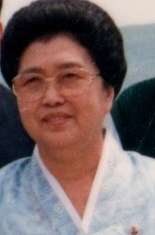Kim Song-ae
| Kim Song-ae | |
|---|---|
 | |
| First Lady of North Korea | |
|
In role December 17, 1963 – August 15, 1974 | |
| Supreme Leader | Kim Il-sung |
| Preceded by | Office established |
| Succeeded by | Ri Sol-ju (2018) |
| Chair of the Central Committee of the Korean Democratic Women's League | |
|
In office 1993 – 25 April 1998 | |
| Supreme Leader | Kim Jong-il |
| Preceded by | Vacant |
| Succeeded by | Cheon Yeon-ok |
|
In office 1971–1976 | |
| Supreme Leader | Kim Il-sung |
| Preceded by | Kim Ok-sun |
| Succeeded by | Vacant |
| Personal details | |
| Born |
29 December 1924 Kangso-guyok, South Pyongan Province, Japanese Korea |
| Died |
September 2014 (aged 89) Kanggye |
| Political party | Workers' Party of Korea |
| Spouse(s) | Kim Il-sung (m. 1952–1994; his death) |
| Children |
Kim Kyong-jin (daughter) Kim Pyong-il (son) Kim Yong-il (son)[lower-alpha 1] |
| Korean name | |
| Chosŏn'gŭl | 김성애 |
| Hancha | 金聖愛 |
| Revised Romanization | Gim Seong-ae |
| McCune–Reischauer | Kim Sŏng-ae |
Kim Sŏng-ae (Chosŏn'gŭl: 김성애, 29 December 1924[1] – September 2014)[2] was a North Korean politician who served as the First Lady of North Korea from 1963 to 1974. She was the third wife of the President of North Korea, Kim Il-sung.
Biography
Kim Song-ae originally worked as a secretary.[3] She married Kim Il-sung in 1952, following the death of Kim Il-sung's first wife in 1949, although due to the Korean War no formal ceremony was held. One source indicates Kim Il-sung had had an affair with her even before his first wife died. She gave birth to a daughter (Kim Kyong-jin, 1953) and two sons (Kim Pyong-il, 1955; Kim Yong-il, 1957).
She later rose in political power. From the mid 1960s until the mid 1970s, Kim Song-ae allegedly held a significant amount of political influence in North Korea.[3] As her tenure of political significance occurred in about the same period as that of Jiang Qing in China during the culture revolution, Jang Jin-sung referred to Kim Song-ae as the "North Korean mirror image of Jiang Qing".[3]
In 1965, she became vice-chairwoman of the Central Committee of the Korean Democratic Women's League (KDWL), and in 1971, she rose to be chairwoman.[4] In December 1972, she became a representative of the People’s Supreme Assembly.[4]
According to Jang Jin-sung, Kim Song-ae had the ambition to place her son, Kim Pyong-il in the position of successor to her spouse Kim Il-sung, rather than his son from his first marriage, Kim Jong-il.[3] In this, she was supposedly supported by a faction of the North Korean political elite, among them her brother Kim Kwang-hop, and Kim Il-sungs brother Kim Yong-ju, and opposed by the faction of her stepson Kim Jong-il.[3] In the 1970s, her influence was reportedly seen as excessive by the party, who started to curb it.[3] In parallel, her stepson Kim Jong-il became the designated heir of Kim Il-sung, and his faction worked to remove her from influence.[3][4] In 1976, Kim Song-ae lost her position as chair of the KDWL, which removed her communication channel to the public and effectively curbed her power base.[3] Reportedly, Kim Song-ae, as well as her brother-in-law Kim Yong-ju, who had supported her plans to place her son in the position of heir instead of Kim Jong-il, was placed in house arrest in 1981 upon the wish of the designated heir Kim Jong-il.[3]
In 1993, she was reinstated by Kim Jong-il as chair of the KDWL, but her position was purely symbolic and nominal, and she was removed a second time in 1998.[5] Since 1998, little information about her has reached the outside world.[6]
In 2012, a report from a North Korean defector claimed that Kim Song-ae had been declared insane in the early 1990s, even before the death of Kim Il-sung, and since then been kept under supervision of a psychiatric nurse in her house arrest.[4]
There are rumors that she was killed in a car accident in Beijing in June 2001.[6] Other reports claim she is still alive as of July 2011, though in poor health, and that Kim Pyong-il returned to Pyongyang from his posting in Poland to visit her.[7]
Select[lower-greek 1] family tree of North Korea's ruling[lower-greek 2] Kim family[lower-greek 3][lower-greek 4][lower-greek 5] | ||||||||||||||||||||||||||||||||||||||||||||||||||||||||||||||||||||||||||||||||||||||||||||||||||||||||||||||||||||||||||||||||||||||||||||||||||||||||||||||||||||||||||||||||||||||||||||||||||||||||||||||||||||||||||||||||||||||||||||||||||||||||||||||||||||||||||||||||||||||||||||||||||||||||||||||||||||||||||||||||||||||||||||||||||||||||||||||||||||||||||||||||||||||||||||||||||||||||||||||||||||||||||||||||||||||||||||||||||||||||||||||||||||||||||||||||||||||||||||||||||||||||||||||||||||||||||||||||||||||||||||||||||||||||||||||||||||||||||||||||||||||||||||||||||||||||||||||||||||||||||||||||||||||||||||||||||||||||||||||||||||||||||||||||||||||||||||||||||||||||||||||||||||||||||||||||||||||||||||||||||||||||||
|---|---|---|---|---|---|---|---|---|---|---|---|---|---|---|---|---|---|---|---|---|---|---|---|---|---|---|---|---|---|---|---|---|---|---|---|---|---|---|---|---|---|---|---|---|---|---|---|---|---|---|---|---|---|---|---|---|---|---|---|---|---|---|---|---|---|---|---|---|---|---|---|---|---|---|---|---|---|---|---|---|---|---|---|---|---|---|---|---|---|---|---|---|---|---|---|---|---|---|---|---|---|---|---|---|---|---|---|---|---|---|---|---|---|---|---|---|---|---|---|---|---|---|---|---|---|---|---|---|---|---|---|---|---|---|---|---|---|---|---|---|---|---|---|---|---|---|---|---|---|---|---|---|---|---|---|---|---|---|---|---|---|---|---|---|---|---|---|---|---|---|---|---|---|---|---|---|---|---|---|---|---|---|---|---|---|---|---|---|---|---|---|---|---|---|---|---|---|---|---|---|---|---|---|---|---|---|---|---|---|---|---|---|---|---|---|---|---|---|---|---|---|---|---|---|---|---|---|---|---|---|---|---|---|---|---|---|---|---|---|---|---|---|---|---|---|---|---|---|---|---|---|---|---|---|---|---|---|---|---|---|---|---|---|---|---|---|---|---|---|---|---|---|---|---|---|---|---|---|---|---|---|---|---|---|---|---|---|---|---|---|---|---|---|---|---|---|---|---|---|---|---|---|---|---|---|---|---|---|---|---|---|---|---|---|---|---|---|---|---|---|---|---|---|---|---|---|---|---|---|---|---|---|---|---|---|---|---|---|---|---|---|---|---|---|---|---|---|---|---|---|---|---|---|---|---|---|---|---|---|---|---|---|---|---|---|---|---|---|---|---|---|---|---|---|---|---|---|---|---|---|---|---|---|---|---|---|---|---|---|---|---|---|---|---|---|---|---|---|---|---|---|---|---|---|---|---|---|---|---|---|---|---|---|---|---|---|---|---|---|---|---|---|---|---|---|---|---|---|---|---|---|---|---|---|---|---|---|---|---|---|---|---|---|---|---|---|---|---|---|---|---|---|---|---|---|---|---|---|---|---|---|---|---|---|---|---|---|---|---|---|---|---|---|---|---|---|---|---|---|---|---|---|---|---|---|---|---|---|---|---|---|---|---|---|---|---|---|---|---|---|---|---|---|---|---|---|---|---|---|---|---|---|---|---|---|---|---|---|---|---|---|---|---|---|---|---|---|---|---|---|---|---|---|---|---|---|---|---|---|---|---|---|---|---|---|---|---|---|---|---|---|---|---|---|---|---|---|---|---|---|---|---|---|---|---|---|---|---|---|---|---|---|---|---|---|---|---|---|---|---|---|---|---|---|---|---|---|---|---|---|---|---|---|---|---|---|---|---|---|---|---|---|---|---|---|---|---|---|---|---|---|---|---|---|---|---|---|---|---|---|---|---|---|---|---|---|---|---|---|---|---|---|---|---|---|---|---|---|---|---|---|---|---|---|---|---|---|---|---|---|---|---|---|---|---|---|---|---|---|---|---|---|---|---|---|---|---|---|---|---|---|---|---|---|---|---|---|---|---|---|---|---|---|---|---|---|---|---|---|---|---|---|---|---|---|---|---|---|---|---|---|---|---|---|---|---|---|---|---|---|---|---|---|---|---|---|---|---|---|---|---|---|---|---|---|---|---|---|---|---|
| ||||||||||||||||||||||||||||||||||||||||||||||||||||||||||||||||||||||||||||||||||||||||||||||||||||||||||||||||||||||||||||||||||||||||||||||||||||||||||||||||||||||||||||||||||||||||||||||||||||||||||||||||||||||||||||||||||||||||||||||||||||||||||||||||||||||||||||||||||||||||||||||||||||||||||||||||||||||||||||||||||||||||||||||||||||||||||||||||||||||||||||||||||||||||||||||||||||||||||||||||||||||||||||||||||||||||||||||||||||||||||||||||||||||||||||||||||||||||||||||||||||||||||||||||||||||||||||||||||||||||||||||||||||||||||||||||||||||||||||||||||||||||||||||||||||||||||||||||||||||||||||||||||||||||||||||||||||||||||||||||||||||||||||||||||||||||||||||||||||||||||||||||||||||||||||||||||||||||||||||||||||||||||
Notes:
| ||||||||||||||||||||||||||||||||||||||||||||||||||||||||||||||||||||||||||||||||||||||||||||||||||||||||||||||||||||||||||||||||||||||||||||||||||||||||||||||||||||||||||||||||||||||||||||||||||||||||||||||||||||||||||||||||||||||||||||||||||||||||||||||||||||||||||||||||||||||||||||||||||||||||||||||||||||||||||||||||||||||||||||||||||||||||||||||||||||||||||||||||||||||||||||||||||||||||||||||||||||||||||||||||||||||||||||||||||||||||||||||||||||||||||||||||||||||||||||||||||||||||||||||||||||||||||||||||||||||||||||||||||||||||||||||||||||||||||||||||||||||||||||||||||||||||||||||||||||||||||||||||||||||||||||||||||||||||||||||||||||||||||||||||||||||||||||||||||||||||||||||||||||||||||||||||||||||||||||||||||||||||||
Works
- Kim Song-ae (1969). Let Us Women Become Revolutionary Fighters Infinitely Loyal to the Party and Reliable Builders of Socialism and Communism by Revolutionizing and Working-classizing Ourselves. Pyongyang: Foreign Languages Publishing House. OCLC 253679297.
- — (1970). On the Women's Emancipation Movement in Korea. Report at the Meeting Held in Honour of the 25th Anniversary of the Founding of the Korean Democratic Women's Union, November 17, 1970. Pyongyang: Foreign Languages Publishing House. OCLC 1012367.
See also
Notes
- ↑ Not the same person as former premier Kim Yong-il
References
- ↑ http://nkinfo.unikorea.go.kr/nkp/theme/viewPeople.do?nkpmno=933
- ↑ 김일성 부인 김성애 사망설 제기
- 1 2 3 4 5 6 7 8 9 Jang Jin-sung: Dear Leader: Poet, Spy, Escapee – A Look Inside North Korea, 2014
- 1 2 3 4 NF|New Focus. Kim Il-sung’s wife was declared insane over 20 years ago. Politics. Tuesday 18 September 2012
- ↑ NF|New FocusRo Song Sil: a key-elite of the North Korean system? Politics. Monday 8 April 2013
- 1 2 Lee Su-gyeong (이수경) (2 May 2006). "김부자 실체: 김정일의 계모 김성애". Radio Free Asia (Korean service). Archived from the original on 27 June 2007. Retrieved 20 May 2007.
- ↑ "Kim Jong-il's Brother 'Under House Arrest in Pyongyang'", Chosun Ilbo, 3 July 2011, retrieved 3 July 2011